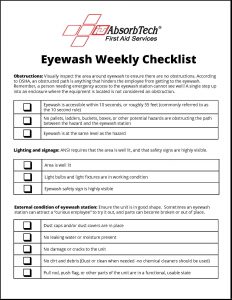Eyewash Station Inspection Template
Jul 5, 2011 - Plumbed eyewash stations require weekly checks to be compliant with ANSI Z358.1-2009, which OSHA may reference during an inspection. The American National Standards Institute’s emergency eyewash and equipment standard (ANSI Z358.1-2014) sets the standard for proper eyewash equipment selection, installation, operation, and maintenance. Msdn library visual studio 60a cd1 and cd2. The eyewash station checklist below covers key points in the ANSI standard in the areas of operation and maintenance.
Introduction When working with corrosives, drenching facilities must be readily available. The Occupational Safety and Health Administration’s (OSHA) Medical and First Aid Standard 29 Code of Federal Regulations (CFR) 1910.151(c) states, “Where the eyes or body of any person may be exposed to injurious corrosive materials, suitable facilities for quick drenching or flushing of the eyes and body shall be provided within the work area for immediate emergency use.” These drenching facilities could include an eyewash, eye/face wash, shower or combination eye/face wash shower depending on the amount of possible exposure. Because OSHA does not clarify what the minimum requirements for “suitable facilities” are, employers often look to the voluntary American National Standards Institute (ANSI) Z358.1-2014 Standard for Emergency Eyewashes and Shower Equipment for guidance. ANSI Z358.1-2014 helps users select and install proper emergency equipment to meet OSHA requirements. Also, OSHA often uses ANSI Z358.1 as a guide during inspections and may elect to issue penalties based on non-compliance. Emergency eyewashes and showers often go unused.
It’s important to test these devices regularly to help ensure they will function properly in an emergency. Studies show that the seconds immediately following an eye injury or chemical splash are often critical to minimizing damage. ANSI Z358.1-2014 Requirements To ensure that eyewash stations and showers are always ready when needed, it is important that the requirements for test procedures and maintenance set forth in Z358.1-2014 be followed. The requirements for testing and maintaining eye, eye/face washes and showers are based on the manufacturer’s instructions and ANSI protocols. Generally, the manufacturer’s instructions state that the devices should be inspected, tested and the results recorded weekly. Individual owners’ manuals should be looked at for the specific manufacturer's guidelines. ANSI Z358.1-2014 is divided into five sections and each section addresses minimum performance and use requirements, as well as installation, testing procedures, maintenance and training requirements.

ANSI Z358.1-2014 Plumbed and Self-Contained Emergency Showers, Eyewash Equipment, Eye/Face Wash Equipment and Combination Units Performance and Maintenance Criteria. • Initial and date in the corresponding box verifying that the emergency eyewash / shower is checked weekly to ensure: • Equipment installed within 10 seconds from the hazard and on the same plane as the hazard • Pathway is clear of obstructions • Plumbed equipment activated to ensure compliant operation and to clear any sediment • Self-contained equipment checked to determine if the flushing fluid needs to be changed or supplemented • Equipment free of broken or missing parts • Equipment protected against freezing • User protected from scalding water. Commonly Asked Questions Q. Who should be trained on the proper use of emergency eyewashes and showers? ANSI Z358.1-2014 states that employees who may be exposed to hazardous materials must be trained on the use of eyewash and shower devices. Specific areas that should be addressed include the location of the units, how to properly activate the systems and how to correctly maintain the devices.
Are there any recommended procedures on how to effectively flush eyes that have been contaminated? Individuals should be instructed to hold the eyelids open and roll the eyeballs so fluid will flow on all surfaces of the eye and under the eyelid.